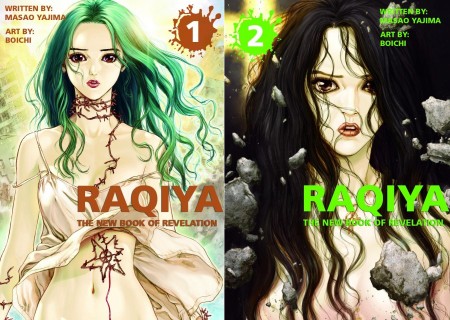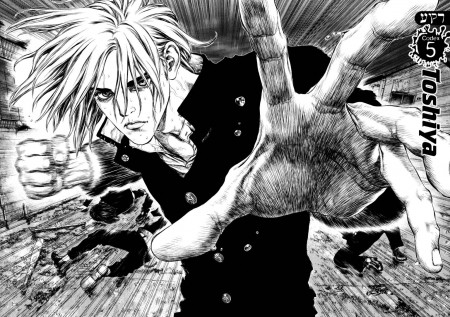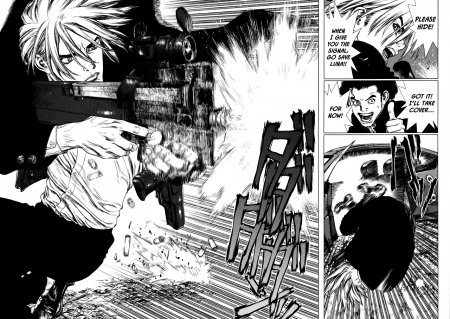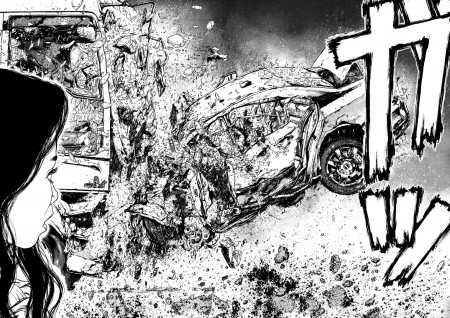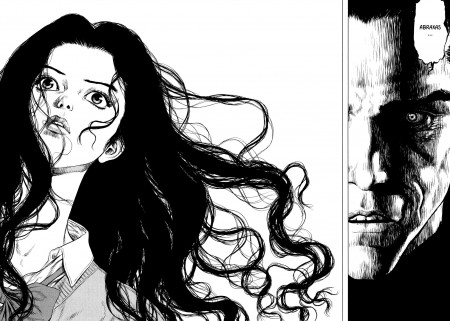Recommendation for Raqiya
Biblical history and esoterica have been subject to literary adaptation for centuries, from Milton’s 1667 dramatization of the fall of Lucifer to modern novels and movies like Left Behind and Legion and Dogma. Despite Japan not being a predominantly Christian country, Scripture has inspired numerous Japanese manga artists as well, including Kaori Yuki’s Angel Sanctuary, Kazue Kato’s Blue Exorcist, Daisuke Moriyama’s Chrono Crusade, Kent Minami’s Angel Para Bellum, and Nanae Chrono’s Vassalord, to name a few. Writer Masao Yajima & illustrator Boichi’s 2008 manga series Raqiya: The New Book of Revelation takes a more prominent than typical approach to adapting Biblical concepts for its own ends, resulting in a tense, provocative action manga for open-minded mature readers.
The first two volumes of Raqiya introduce readers to Luna Hazuki, a Japanese teen girl who maintains an optimistic and cheerful disposition despite having survived not just one but two tremendous “accidents” that have left her the only survivor of her family. Perhaps by godly design or fate, Luna is saved from tragedy, or the people around her suffer for their relationship with her, due to her childhood pact with a heretical angel. As the body count rises, the day when the ultimate fulfillment of Luna’s supernatural bargain will unfold marches closer, and no one seems to know if that cataclysmic day will spell ascension or apocalypse.
Masao Yajima’s story moves quickly but unfolds slowly, transitioning Luna from an innocent child to a high school girl, Nevada to Tokyo, and from one family to another in a flash. The story also projects an endless torrent of threats toward Luna ranging from paranoid stalkers to a powerful underground religious cult to literal supernatural beings. But at the end of two books, readers still don’t know anything about Luna’s true nature. The mystery is both intriguing and frustrating. Most of the first volume depicts Luna fortunately stumbling into safety, keeping her supernatural character in reserve. The second volume begins to reveal more overt clues yet still plays coy with definitive answers, which may fascinate some readers as much as frustrate others. Luna Hazuki is distinctly the series’ protagonist, but after two volumes, the reader still can’t tell whether she’s an angel or a devil. The manga subtly suggests that just as the characters that surround Luna view her differently, readers may also perceive her as a demon or an angel depending on their personal perspective.
The core cast of characters is small, and each character is given ample introduction time to allow each character to become distinctive and significant to the story. The manga is relatively dialogue heavy but not frequently excessively expository. The dialogue feels natural given the number of characters in the story and the complexity of the tale. Particularly the first volume has a somewhat incongruous tendency to inject visual gag humor, partly to lighten the story’s oppressively grim tone, and partly to add depth to the core characters. A subtle but appreciable weakness in the writing is the lack of complex characterizations from the main cast. Luna and her two male friends are largely one-dimensional characters that never express fear, anxiety, or sadness. The fact that they’re unaware that they’re the target of a sinister religious cult’s obsession partially justifies their limited emotional expression. But emphasis on rushing the story development ahead also compromises opportunities for complex character development. So the manga injects moments of gag humor to trick readers into associating more than one expression and emotion with each character.
Korean illustrator Boichi’s graphic art is characterized by a stylized realism that evokes some parallels to the art of Ryoichi Ikegami, Oh! Great, Takehiko Inoue, and Hiroshi Takahashi. As is frequently the case with Korean illustrators, the artwork is filled with deep, heavy textures, expansive shadows, and frequently staggering visual detail. Careful examination of the art reveals some odd discrepancy in design. Particularly the teen boy character Toshiya looks like he belongs in an entirely different manga because his character design style is so unlike every other character in the manga. But since the point of his character design is to distinguish him from his classmate & friend Isa, the incongruous design is forgivable. As this is a supernatural action manga, action scenes are periodically quite gruesome, although Raquiya doesn’t reach the heights of graphic gore and mayhem of other over-the-top manga like Berserk, Battle Royale, or Shigurui.
One Peace Book’s English language publication of the first two of five total volumes of Raqiya meet the standards one expects of any manga published by any of America’s foremost manga publishers. The book covers are glossy card stock. The interior pages are standard manga print. As is frequently the case with English translated manga, the initial color pages in the original Japanese publication are reproduced in monochrome in the English language books. Blacks are bright and vivid. Screentones are crisp. The graphic art is presented unaltered; sound effects are translated unobtrusively. I noticed only one typo in the second volume, the word “who’s” misspelled as “whose.” I was also a bit surprised to see the first book reference “Shimakousaku” without a footnote or translation – a reference to Kenshi Hirokane’s popular (in Japan) business manga Kacho Kousaku Shima – a brief reference that will leave most American readers scratching their heads.
Devout Christians probably won’t appreciate the grand liberties that author Masao Yajima has taken with his Raqiya manga, but even a brief glance at the series will suffice to establish Raqiya: The New Book of Revelation as a gratuitous, adult-oriented manga strictly for readers with eclectic sensibilities. The first two volumes contain ample scenes of graphic, bloody violence and gore, and very brief nudity and ritualistic sex. However, readers that enjoyed the Biblical-infused kinetic action of Spriggan or who enjoy contemporary action/suspense/horror manga titles like Rose Hip Zero, Variante, High School of the Dead, and Ajin: Demi-Human should be quite pleased with Raqiya. Given the revelations after two volumes, I personally would have appreciated just a bit more explanation; however, ominous, foreboding and grim contemporary action manga for mature readers remain rare in English, so Raqiya: The New Book of Revelation is a very welcome offering, providing impressive visual art and a substantial story that will keep readers guessing. The first two volumes are scheduled for official American release on October 14 but are widely available now.
